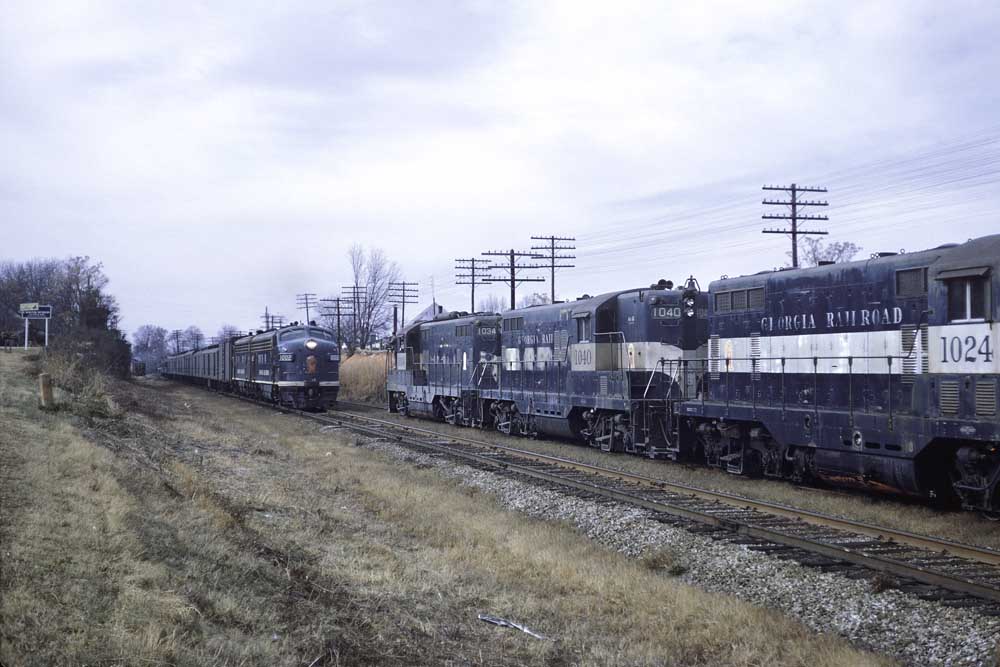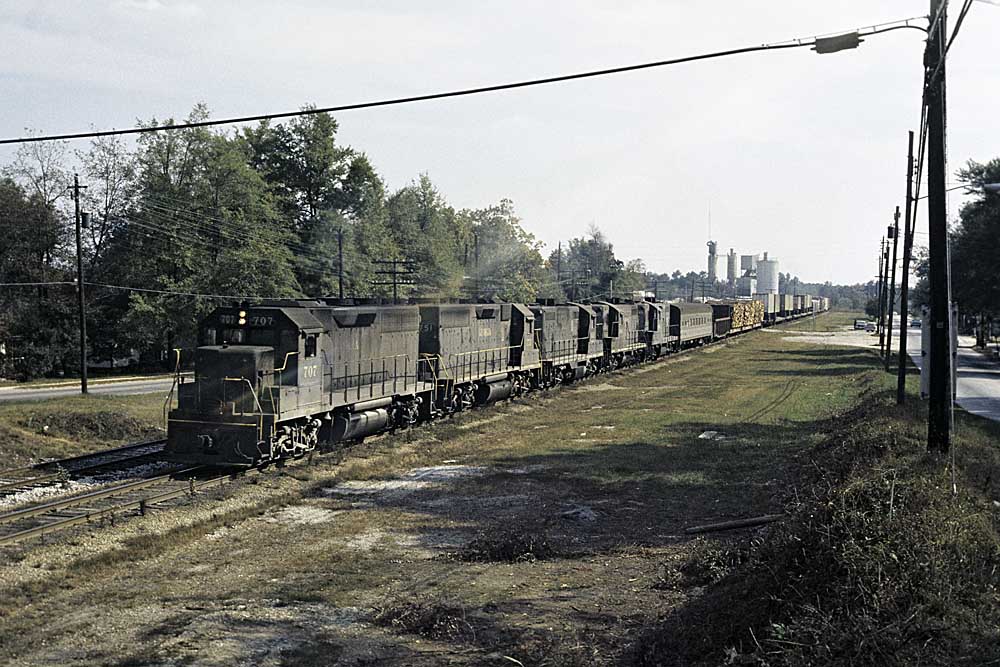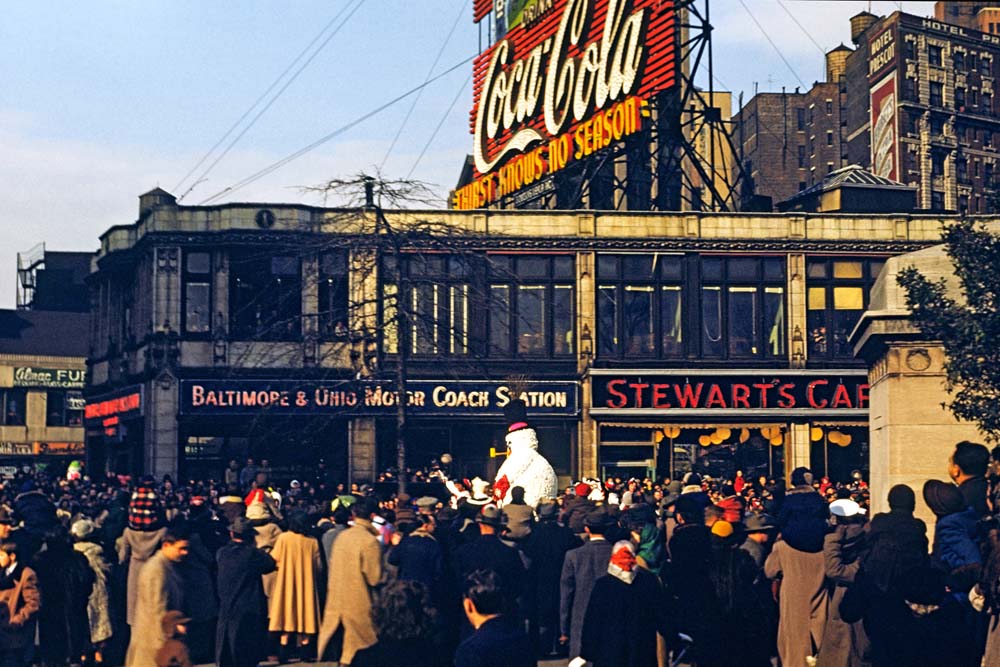In its rich 150-year history, the Georgia Railroad was touched and torched by the rich and famous. During the process, the company morphed from a railroading pioneer and leader in the Peach State to an interesting combination of Class I and short-line operation.
Started as The Georgia Railroad in 1833, the ambitious company hired chief engineer John Edgar Thomson to design a railroad linking the navigable Savannah River at Augusta westward to the heart of the state, at a point to be determined.
Within a short time, the perennial clash of ambitious ideas and a paucity of money caused a significant rethinking. On Jan. 12, 1836, the charter was amended to permit financial commerce as well as transportation by the Georgia Railroad & Banking Co. Banking proved just the ticket to financing the rail project, which by 1844 reached 171 miles across mid-Georgia to Marthasville or Terminus, later named Atlanta. Another railroad, the Western & Atlantic, later of Andrews Raiders fame, was already under construction from Terminus north toward the Tennessee River.
Office politics soon entered into the enterprise, resulting in intermediate points being named for wealthy principals in the firm, including Thomson, Dearing, and Camak. Engineer Thomson did an excellent job with his design. He found a route that went west 80 miles to the Oconee River, west of Greensboro, without any type of bridging, not even a culvert, required. In a region laced by rivers and getting 47 inches of annual rainfall, that was quite an accomplishment. Thomson’s later efforts in building and operating the mighty Pennsylvania RR across the Alleghenies, including Horseshoe Curve, called on bridging and tunneling talents that were not called for in his first railroad endeavor.
Conceived to capture traffic on the Savannah River, to and from its namesake port, the Georgia Road, as the railroad came to be known, enhanced its franchise by a connection with the South Carolina RR at Augusta. This provided access to a second port at Charleston, S.C. The Western & Atlantic gave it access to the Tennessee River at Chattanooga, which commenced a century-long competition with the Central of Georgia Railroad, a firm which served most of the same key Peach State cities and also possessed a direct rail line to Savannah.
Cotton, along with other products of the plantations and forests, flowed toward Augusta and Savannah. Manufactured goods from the North and Europe moved inbound to partially balance tonnage flows. Early investments in the predecessors of the Atlanta & West Point Railway and its connection, the Western Railway of Alabama, soon provided an extended rail avenue via Atlanta into the heart of the South at Montgomery and Selma, Ala.
No sooner had the Georgia Road settled into a profitable and effective transportation link than the “Late Unpleasantness,” i.e., the Civil War, swept over the nation. The dramatic increase in traffic during the hostilities came to an abrupt halt when Gen. William T. Sherman captured Atlanta and destroyed all rail terminals there, plus more than 80 miles of Georgia RR main line. All the way past Madison, Sherman’s “scorched earth” policy was manifest in flames and destruction of rail, ties, the few bridges, and every lineside structure. Only the right-of-way remained.
It took more than a dozen years to heal the physical and financial damage. During that time the owners found banking more to their liking, and much more profitable. In 1881 they leased the Georgia RR jointly to the Louisville & Nashville and rival Central of Georgia. The Central soon lost its financial interest through a reorganization, giving the L&N uncontested control. Thus, the Georgia RR and its related interests joined “The Family Lines” in the late 19th century.

Expansion via short and branch lines
To build traffic, especially lumber and farm goods, the company nurtured several short lines. They included the Union Point & White Plains, Washington & Lincolnton, Elberton & Eastern, Lexington Terminal, Milstead, and Milledgeville Railway. All succumbed to abandonment during the Great Depression or in the years following World War II as cotton faded and the forests were logged out.
Over the years, the Georgia Road’s 171-mile main line expanded to a network totaling more than 300 route-miles. Several branches reached regional communities, the longest being “The Macon Road,” which stretched 78 miles south from Camak to Macon. The branches are what gave the Georgia its short-line character. Most were served by ancient or rebuilt 4-6-0s hauling mixed trains with Jim Crow combination cars. These trains, with their leisurely pace, gave the company a unique flavor, even into the diesel era.
Traffic generated on-line consisted primarily of forest products, clay, and gravel, plus cotton and cottonseed products. Coal, flour, lumber, petroleum, sugar, textiles, and miscellaneous manufactured goods came from connections, much of it “bridged” to other roads at Atlanta or Augusta. In 1929, just over 100,000 carloads moved over the Georgia, which offered good connections with parents Atlantic Coast Line and L&N (controlled by ACL), plus other Family members at both ends.
Through freights 209, 210, and 211, train numbers mirroring similar numbers on parent Coast Line, plied Georgia’s main line. Supplemented by a regular eastbound extra to balance motive power, these trains provided service roughly every 12 hours in each direction. Except for pickups and setouts at Camak, the junction with the Macon branch and the Savannah & Atlanta Railway, these trains moved bridge traffic between connecting roads at Atlanta and Augusta. Four local freights worked the mainline customers and fed the branch-line mixed trains. The Macon Road had its own set of daytime mixed and nighttime local freights.
Pulpwood, lumber, brick, and aggregates were the principal on-line commodities until Georgia Power built its giant generating plant on Lake Sinclair near Milledgeville in the early 1960s. Eventually the only reason for retaining the line was for unit coal trains from Kentucky. The 28-mile portion of the Macon Road west of Milledgeville was abandoned in 1985. Coal became a key revenue source in the latter days of the Georgia and caused the last pioneer construction on the property. A long-planned 1-mile connecting track at Camak enabled continuous movements of trains from Atlanta to Milledgeville and vice versa.

Varnish, from vanilla to unique mixed trains
Mainline passenger service after 1945 consisted of daylight trains 1 and 2 and nocturnal trains 3 and 4. Eastbound 2 and 4 departed Atlanta exactly 12 hours apart, at 9 a.m. and 9 p.m. Their westbound companions left Augusta at 1:50 a.m. and 12:15 p.m. The night trains offered Pullman sleeper service between Augusta and Atlanta, along with through cars between Atlanta and both Charleston, S.C., and Wilmington, N.C., via the ACL. All four trains did a substantial express and mail business, with Railway Post Offices serving many intermediate points across Georgia. After the night trains were discontinued, Nos. 1 and 2 offered some of the last regular heavyweight passenger service in the South. No stainless steel or fancy paint routinely graced these workaday runs.
Post-1966, the Georgia was steadily integrated into “The Family Lines,” losing its unique characteristics. Railway Post Office service ended in 1967, after 120 years (broken only by the war years 1861-65). The night passenger trains were dropped, and soon the day trains were converted to mixed trains, which lasted until 1983, a dozen years into the Amtrak era. (An exemption from ad valorem taxes in the Georgia’s charter implied that it had to provide daily passenger service.)
Piggybacks, general freight, and even coal showed up on the “super mixeds,” which would run 50 cars or more. The branch-line mixed trains were curtailed, clearly signaling the beginning of the end. On Nov. 4, 1982, the Georgia, oldest member of the Family Lines, was acquired by Seaboard Coast Line, which filed to end the mixed trains. On Jan. 1, 1983, SCL and other “Family” members became Seaboard System Railroad. The branch-line mixed trains ended on April 29, 1983, and the mainline runs on May 6.
Only three years later, Seaboard joined Chessie System to become CSX, which blankets the nation east of the Mississippi. The old Georgia Road main line continues to connect segments of CSX, but little remains of the old down-home character and flavor.














During the late Spring and all Summer of 1966, I attended an Army radio school at Fort Gordon, Georgia, outside of Augusta, while on military leave of absence from the MKT RR. I spent many weekends in Augusta chasing trains (on foot) on the GARR, CGA, ACL, and SOU and my favorite was the GARR because it reminded me very much of the MKT.
One weekend in late June, I rode the GARR psgr train from Augusta to Atlanta. and became friends with the condr and showed him my pocket watch and watch card, hospital assn card, switch and cabose key, and rules card. He told me that the the train arrived at Atlanta, to stick with him and he would arrange for me to stay at the RR hotel, which he did at the RR rate.
That being said, Atlanta was a wondrous place to watch trains while on foot. I photographed trains of the WRYA, A&WP, GARR, L&N (w/C&EI power), ACL, SAL, and SOU all day long and then met the GARR psgr train crew for supper where they paid for my meal. On Sunday, I caught the psgr train for the return trip to Augusta and purchased an outstanding fried chicken box lunch at Camak or Social Circle (I can no longer remember which) and the condr or a trainman spent time with me telling me about the industries and businesses served by the GARR along the right-of-way and how the locals were arranged at that point in time.
In Augusta proper, there was always an eclectic mix of road power for the GARR, WRYA, and A&WP. All things considered, the power was very well maintained and most of the F-units I saw looked like they had not only been washed but also polished because they definitely shined. Because the GARR train dispatchers were at the yard at Harrisonville at Augusta, I was never able to visit that office since I didn’t have an auto.
During my four months at Fort Gordon, I made five trips to Atlanta on the psgr train and always had a great time and got lots of photos that are one-of-a-kind. I was particularly pleased to see MKT E-8’s show up in Atlanta beginning in mid-July, 1966, apparently purchased by ACL from Precision National to supplement their existing fleet of E-units. My caboose key still operated the door locks on those engs, too.
The Georgia RR made a very positive impression on me while I was at Fort Gordon. It was a mom-an-pop operation like the MKT but much shorter, it was a classy operation, and the employees I encountered were both professional railroaders and definitely friendly to me.
Thanks for the fine memories of the “Georgia Road”, very good examples of how it was very much a “proud” railroad. That great fried chicken was from Rachels at the Camak station, it was surely some of the best chicken to be had anywhere, too bad the little colonel from Kentucky did not have that recipe!!, Again thanks for the memories.
The Georgia Railroad’s proud commitment to racial segregation was also on full display on its intra-state passenger trains until the passage of the Civil rights Act of 1964.
On November 25, 1955, the (then existent) Inter-state Commerce Commission ruled that that racial segregation on inter-state trains (and passenger buses) had to cease by January 10, 1956. The ICC also ruled that segregation of passengers on inter-state travel in public waiting-rooms (changing trains, or waiting to board) was also unlawful.
However, in Georgia, the State’s Attorney General and the Georgia Railroad, continued their staunch commitment to racial segregation. Eugene Cook, then Attorney-General of Georgia, along with the Railroad, said they would try to use all legal procedures to maintain racial segregation “on travel within Georgia itself.” The Railroad conceded the difficulties because, “…it is often hard to separate inter-state travelers from those travelling within the state alone…” However, where their services originated and terminated in Georgia. They would give first priority to Georgia’s continued resistance to the ICC’s ruling as it did not regulate transportation that was purely intra-State.
In the “Official Guide” of the Railroads in the early and mid-1950s Georgia Railroad time table alerted passengers to the fact that reserved coach seating in their named trains were for “white passengers only”.
In early 70s my summer vacation in middle GA ended by taking the mixed-freight from Macon to Camak and then the main line to Augusta. Then airplane to NJ.
Nice article about a fine railroad. Always enjoyed my ride to work passing by the coaling tower in Social Circle. I miss the fried chicken in Camak.